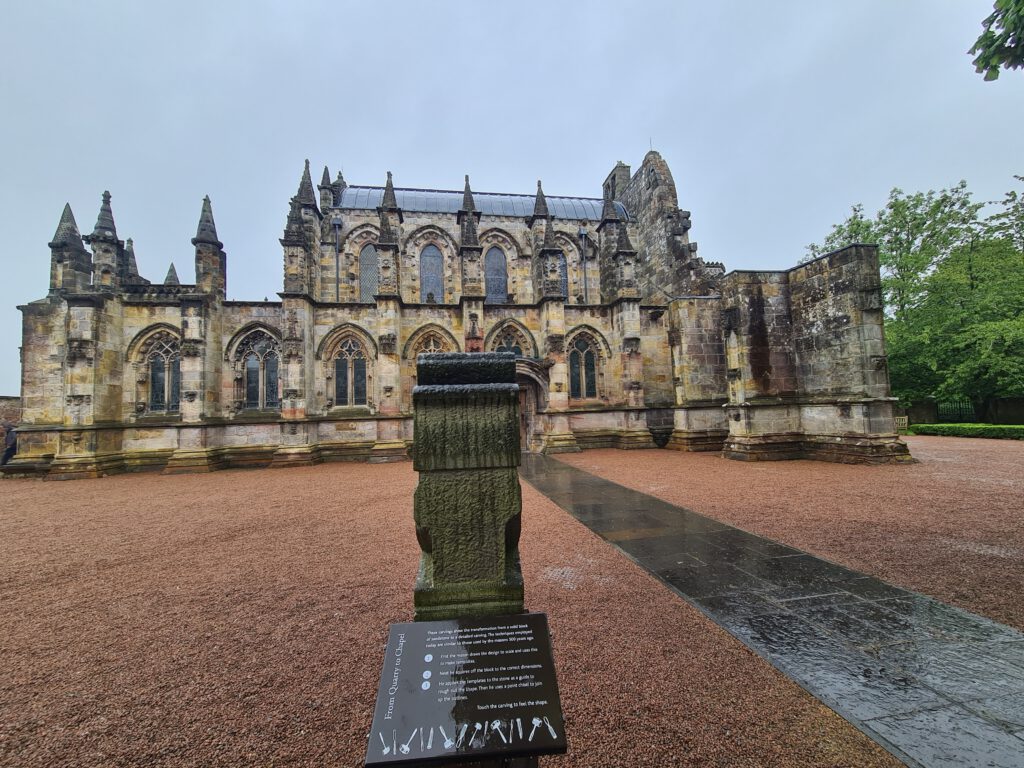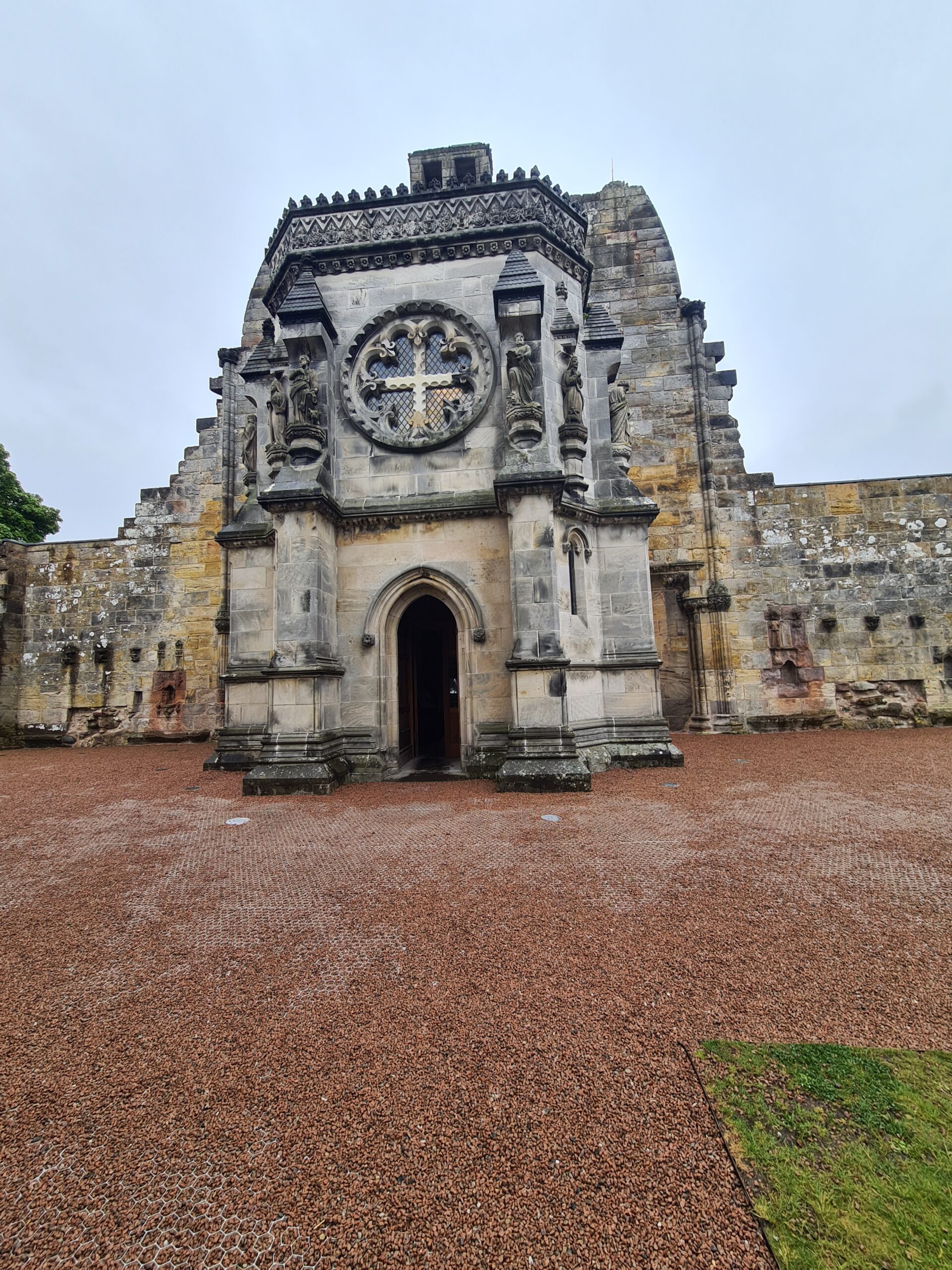Also spelled: Roslin Chapel
Location: near Roslin village, Midlothian, Lowlands of Scotland
kind of building: Gothic style Chapel
today: active chapel, open to public
public transport: buses from Edinburgh City Centre to Roslin, short walk from busstop
scheduled monument: yes
managed by: Rosslyn Chapel Trust
owned by: Peter St Clair-Erskine, 7th Earl of Rosslyn
entrance fee: £ 9.50 (adults, prices are subject to changes, so please recheck with the official website before you visit)
opening times: open daily, for updated information please recheck The Official Rosslyn Chapel Website | Explore the History
directions: Google Maps
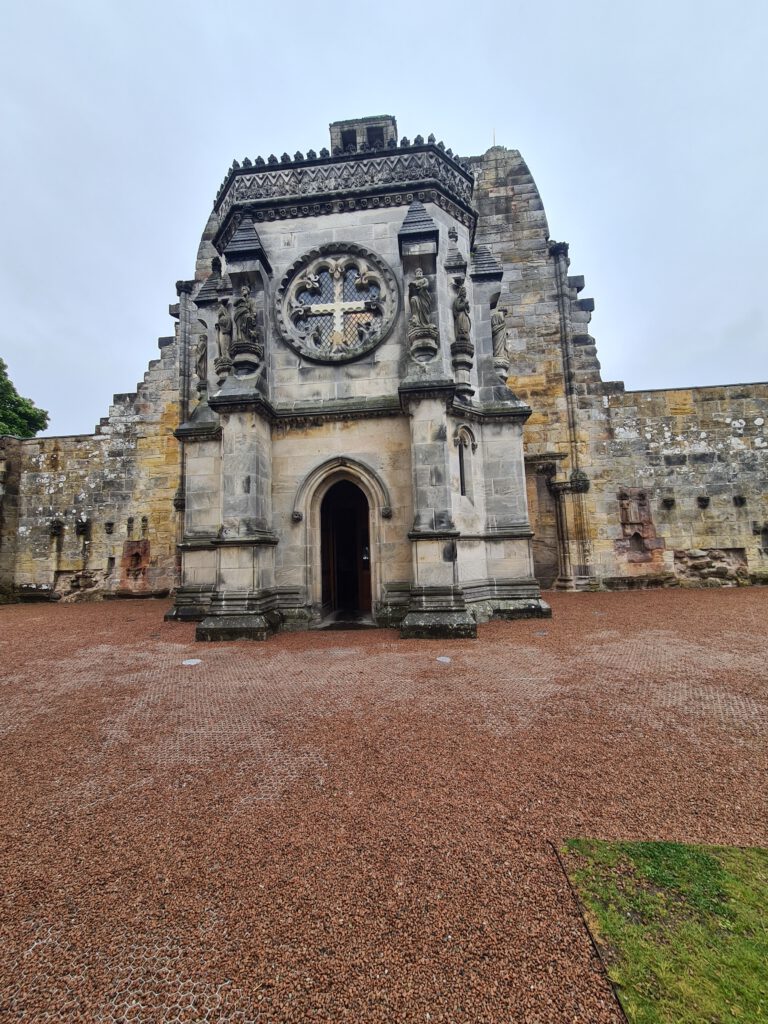
Roslin Chapel can easily be spotted at the end of the infamous movie The Da Vinci Code, maybe best known for starring in this movie Roslin Chapels history is way different to the movies story. Located next to Roslin Castle and not too far off the site of the Battle of Roslin, which was fought more than a hundred years before the founding of the chapel in 1446.
Originally being built as a family chapel for the Sinclairs, Rosslyn Chapel saw a rich and yet at times, turbulent history. The first parts of the chapel were built by Sir William Sinclair who died in 1484, leaving the building incomplete. After his death he of course was buried in his chapel. Sir Oliver Sinclair, his successor and son was the one who abandoned his father’s original design of a much larger possibly cruciform building and roofed the choir.
It was William who dedicated the Chapel, with its extraordinary architecture and carvings, to St Matthew. And truly the inside even more than the outside of the chapel is something special, which luckily can still be seen to this day, something extraordinary.

With the Reformation the more turbulent time of the chapel’s history started, around 1571 the provost of the chapel alongside the prebendaries were forced to resign, before 21 years later, in 1592, Oliver Sinclair was forced to destroy the altars of Rosslyn, which led the chapel to fall into disuse and following, into disrepair. Then in 1650 Cromwell’s troops attacked Rosslyn Castle, using the Chapel as stable for their horses.
After Cromwell took the Castle, Sir William Sinclair died at the Battle of Dunbar, being thought to be the last knight in full armour buried below the Chapel in the vault, as many of his ancestors were before, in family custom. Almost 150 years after the chapel altars were destroyed Sir James Sinclair re-laid the floor and repaired the roof in 1736.
Loving the landscape surrounding it as well as the overgrown ruin if the Chapel, many poets, writers and artists were using it as a muse between the 18th and 19th century, along those being Alexander Nasmyth, the famous Robert Burns and Sir Walter Scott who wrote about Rosslyn in his Lay of the Last Minstrel, which brought the writer immediate success and widespread recognition.

These famous people and especially Sir Walter Scotts publication brought fame and a massive influx of visitors to Rosslyn Chapel. At his home in Abbotsford, he had some of the Chapel’s carvings copied, you can still spot them there to this day.
The obsession over Scott didn’t stop at his home in Abbotsford though. The architect of the infamous Scott Monument in Edinburgh used Rosslyn Chapel as an inspiration for the design used in The Scott Monument in the end.
Myths and legend as well as the history of the Chapel, Castle and the Sinclair family were for sure one of the reasons that kept Scott interested as a storyteller as well as a historian, during his many stays close by.
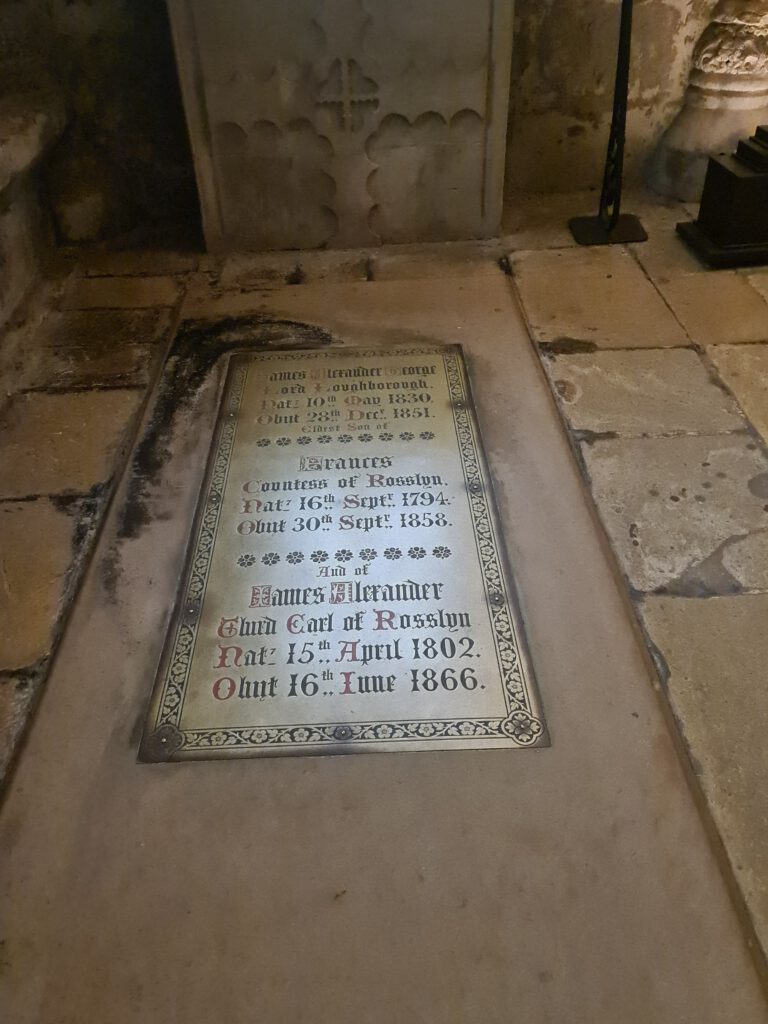
In 1700 Father Richard Augustine Hay’s mother married a member of the Sinclair family, which led Richard to compose a three-volume study of the St Clair family. With the documents he used for his research vanishing in 1835 and so his account is now the most detailed record of the family history.
Alongside poets, writers and artists there were also famous royal visitors with Queen Victoria paying the Chapel a visit in 1842, expressing the desire to have it ‘preserved for the country’ which might have led to the 3rd Earl of Rosslyn, James Alexander, ordering restorations to be carried out, making the Chapel useable again, around 1862. At the same time the chapel was rededicated by the Episcopal Bishop of Edinburgh and consequent Sunday services returned, after nearly 200 years.
Suffering under a terrorist attack on 11 July 1914 the chapel suffered badly. A bomb exploded inside the building as part of a series of politically motivated bombing and arson attacks nationwide, other attacked places for example were Westminster Abbey and St Paul’s Cathedral alongside approximately 29 other churches.

During the 1950s there were a number of conservation works undertaken at the Chapel, such as the roof being repaired and the carvings being cleaned and coated for protection, also adding glass windows.
Further reports spoke about damage occurring due to humidity, in 1995, which was the reason for more conversation work being undertaken, creating the Rosslyn Chapel Trust to conserve the building and eventually open it to the public. Building a canopy over the chapel to protect the walls from the elements, the stonework was finally allowed to dry out naturally, preventing it from green algae to cover it even more. Various parts of the conversation project took as long as 2013 to be fully finished, with three human skeletons being discovered.
In the meantime, Rosslyn Chapel starred in the movie The Da Vinci Code, was awarded a funding of 4.9 million Pounds by the Heritage Lottery Fund and Historic Scotland which was a very big part of even being able to complete all this conversation, which was so badly needed. To attract even more visitors, new visitor facilities were developed, just in front of the chapel, to present the history of the place and give people the opportunity to enjoy a nice treat at the wee café with great views over Roslin Glen.

All of this was crowned in May 2012 when Rosslyn Chapel gained a royal seal of approval with the Earl and Countess of Rosslyn welcoming her (back then) Royal Highness The Duchess of Rothesay at the Chapel for the official opening of the new Visitor Centre.
Ever since the 1980s, there have been speculations, trying to connect the chapel with the Knights Templar, the Holy Grail and Freemasonry; according to many historians there is no basis for those theories and so it is relatively easy to say that the connection between Dan Brown’s The Da Vinci Code and Rosslyn Chapel is purely fictional.
Aside of its rich and interesting history, Rosslyn Chapel definitely has to offer an interesting design which I will introduce you to, now as well.
First there is something that has to be clarified, the Lower Chapel or sacristy is not what is referred to as the burial faults underneath the chapel. For years the crypt had been used to burry members of the Sinclair family, accessible from stairs at the rear of the chapel. Some time ago it was sealed though and when the 2nd Earl of Rosslyn had died in 1837, he wished to be buried in the family faults beneath the chapel, but the entrance couldn’t be found anymore. There was a search undertaken for about a week, but nothing was found and, in the end, his last wish couldn’t be fulfilled and he had to be buried next to his wife in Lady Chapel.
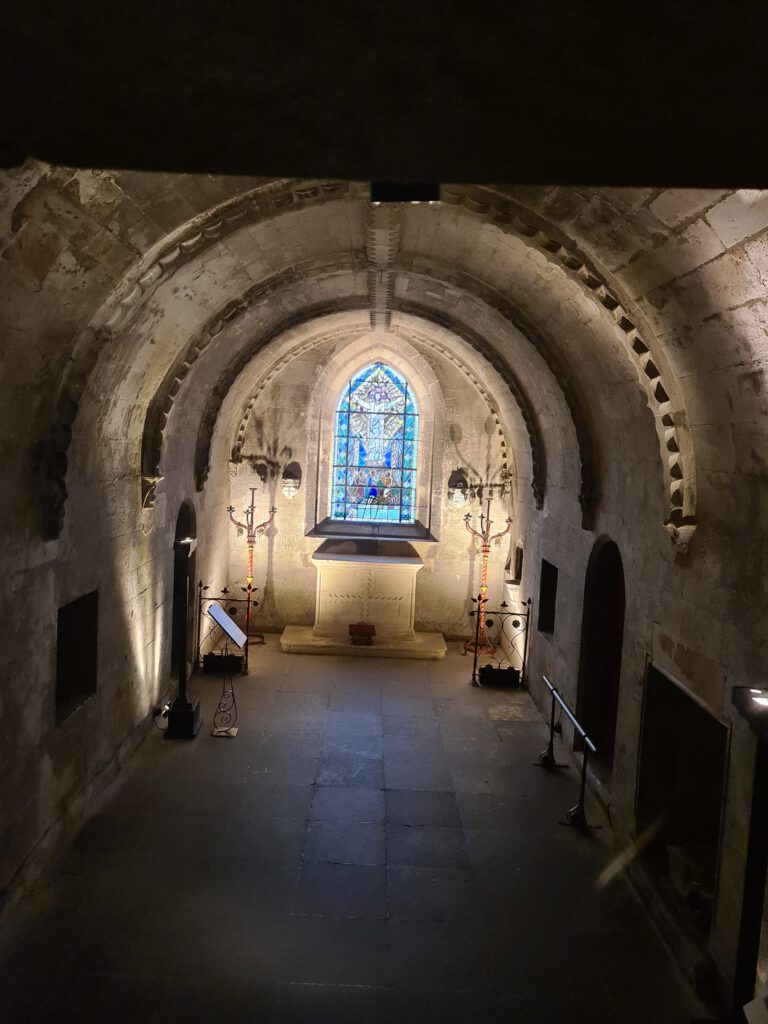
The old burial vault’s exact location and entrance, to this day, are a mystery which led many to the believe that the mummified head of Jesus Christ, the Holy Grail, the Templars treasure or even the original crown jewels of Scotland are buried there alongside the remains of several Sinclair generations. I personally would love extensive research to be undertaken, maybe scanning the ground with some sort of technology, not for the legends to be proven right or wrong but more so for the 2nd Earls last wish to be fulfilled.
Being built on fourteen pillars, all in all, however, the most famous ones for sure are the three pillars at the east end of the chapel, since only those three are named – the Master Pillar, the Journeyman Pillar and the Apprentice Pillar, originally named the Earl’s Pillar, the Shekinah Pillar and the Prince’s Pillar. The most famous one of those three is the Apprentice pillar, which like the crypt of Rosslyn Chapel has a legend surrounding it.
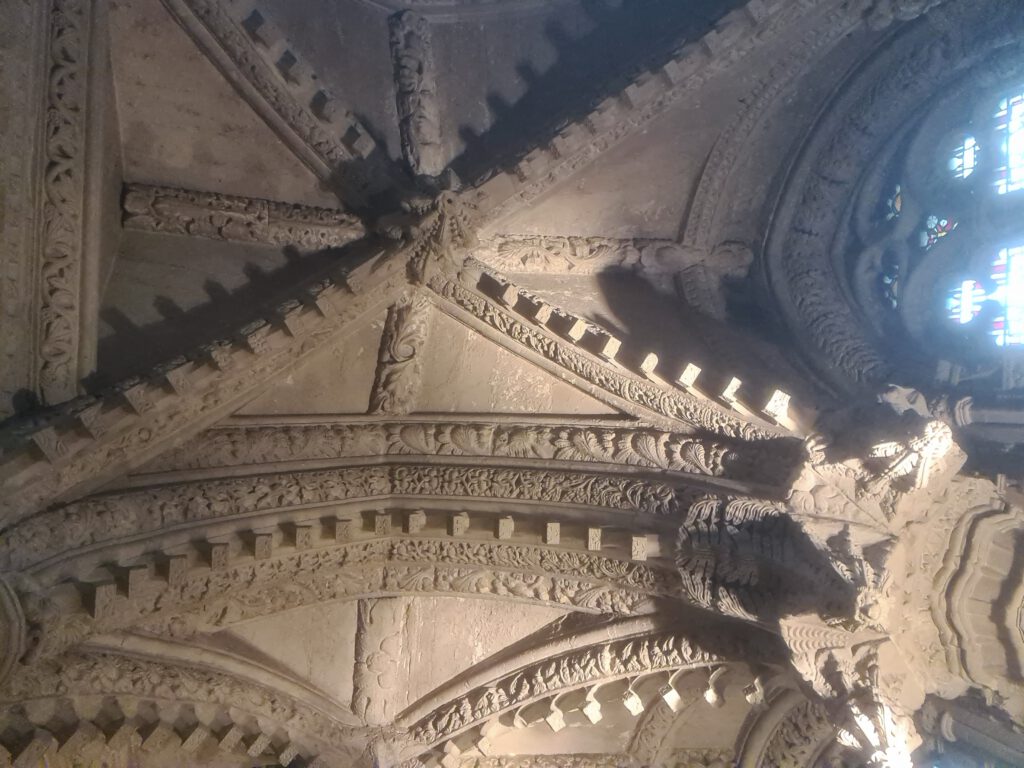
To summarize the long legend, it can be said that the master mason didn’t believe the apprentice wouldn’t be able to carve the column without seeing the original inspiration, believing it to be too complicated of a task. So, the master mason travelled to see the original, when he came back the apprentice had already finished the column all on his own which made the master angry and taking his mallet, he struck the apprentice on the head, eventually killing him. As punishment the masters face was carved into the opposite corner, having to face his apprentice’s masterpiece for eternity.
As the term “legend” already concludes, there is absolutely no evidence of such an event/murder ever occurring.
Alongside the famous pillars there are quite a couple of other carvings inside the chapel as well as on the outside of the building. One of those carvings being a sequence of 213 cubes with patterns on them, however, these days due to the previous conditions of the chapel, those patterns are, on many of those cubes, not the original anymore.
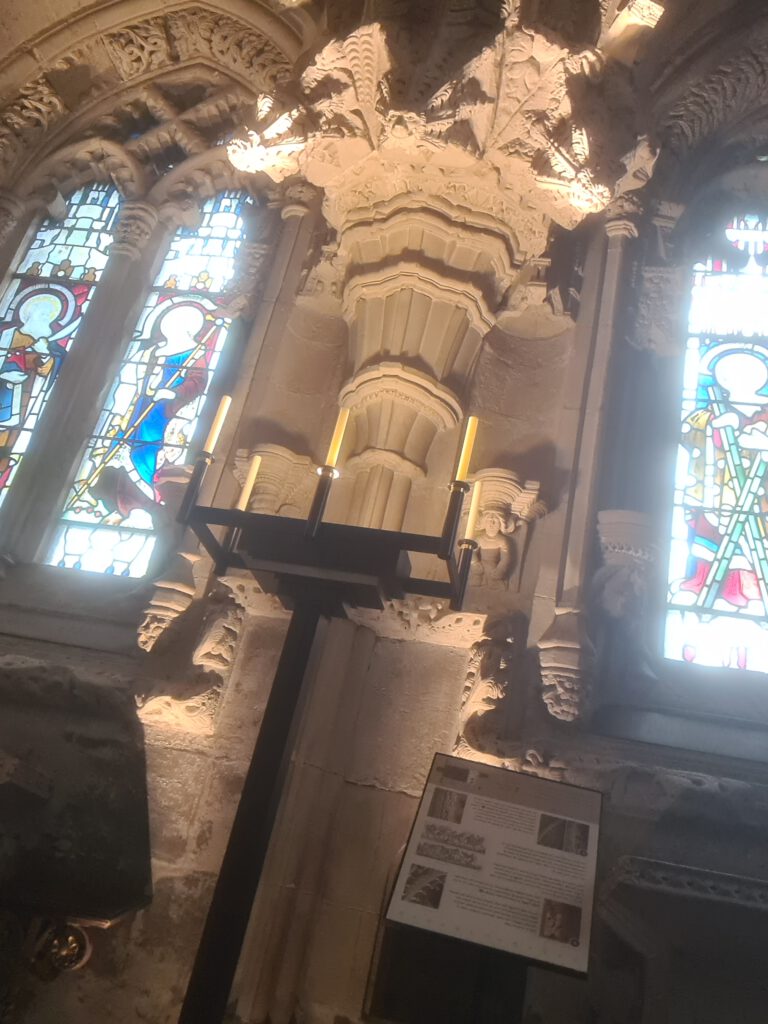
Other famous carvings are of plants like wheat, strawberries or lilies as well as the carvings of “Green Men” over a hundred around the whole chapel, those so-called Green Men are carvings of human faces surrounded by greenery, often growing out of their mouths. Some of those can be spotted between the two middle altars, in the Lady Chapel.
One more interesting architectural part of the Chapel for sure are the rooftop pinnacle which, as previous renovations have shown, were from the beginning on used to harbour bees, with a chamber existing on the inside, when found in 2010 still containing a hive, though abandoned.
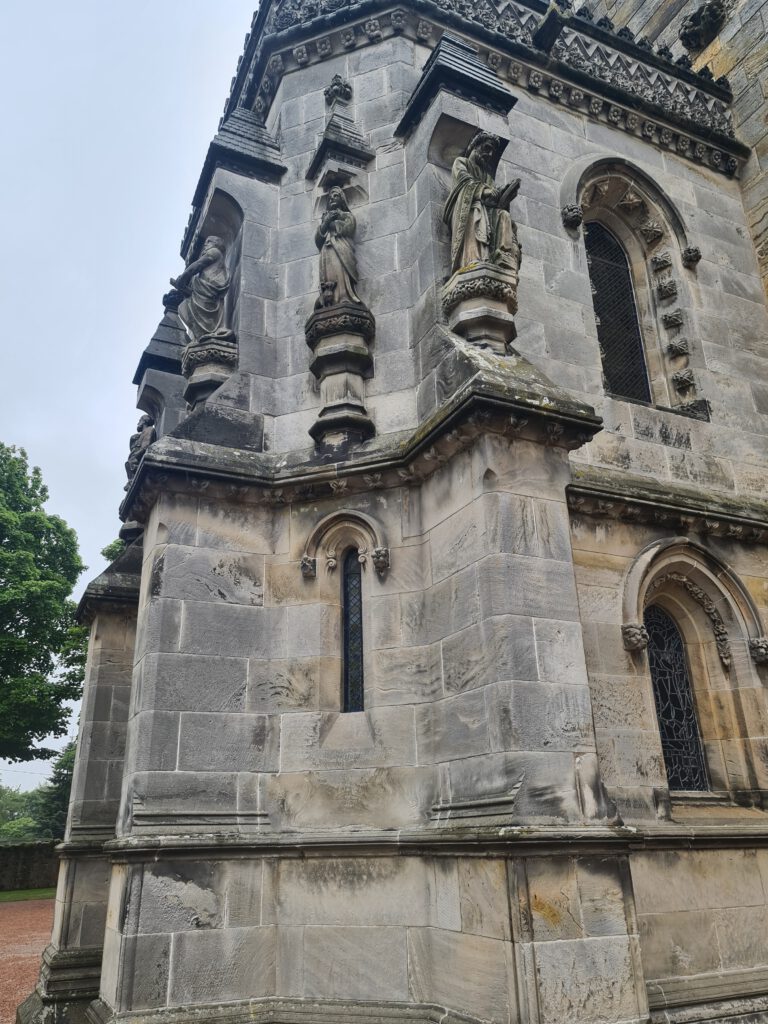
Though The Da Vinci Code is fictional and there are no sure ties between the Templars and Rosslyn Chapel, there are some interesting facts to find, which follow in some confusion for believers of the Knights templar and the holy grail stories. One of those connections being the symbols in Rosslyn Chapel of which a couple are similar to templar symbols, such as the two riders on a single horse which can be found on the Seal of the Knights Templar as well.
Several generations of Sinclairs also stating that they were Grand Masters of the Scottish stonemasons or Grand Master of the Grand Lodge of Scotland. In all of this even the Apprentice Pillar played a central role, with several sources suggesting that it was used as a physical reference to the Apprentice degree of Freemasonry, making the other two pillars the Fellow of Craft and Master Mason’s Degree references. Like so many other theories this theory was proven wrong as well since the degrees weren’t invented as such until 300 years after the chapel was founded.
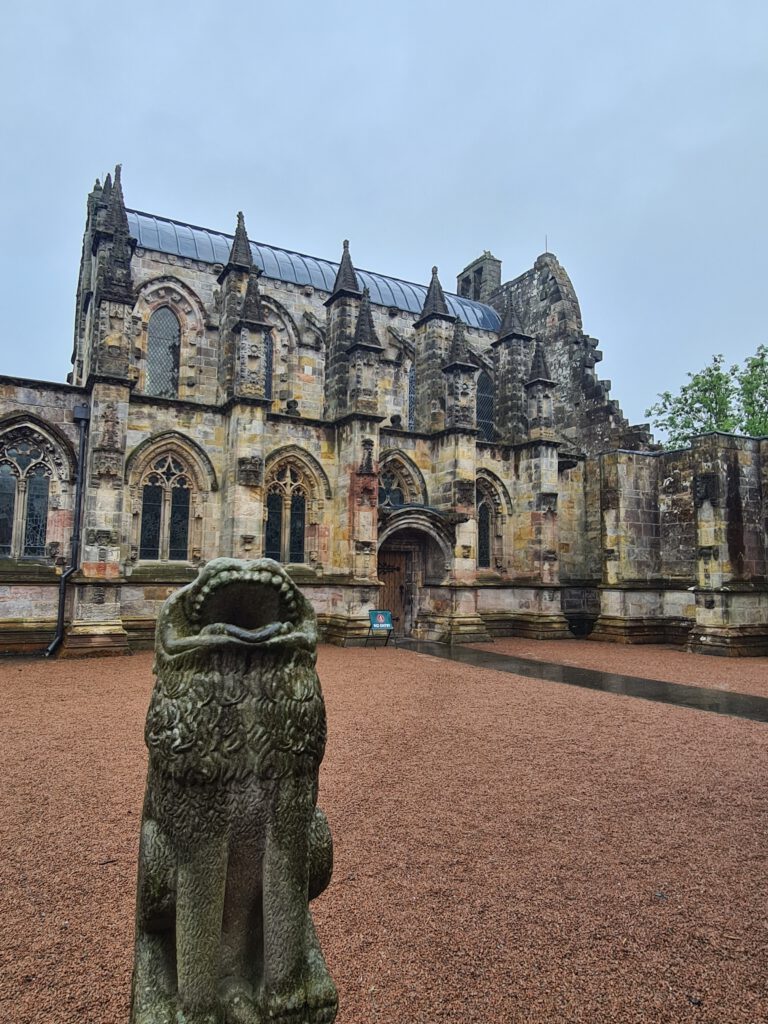
Very interesting to know is that Rosslyn Chapel and the East Quire of Glasgow Cathedral are a complete match to each other. The Cathedral being bigger than the Chapel is the only real difference, they even have the same number of windows and exactly the same number of pillars, which creates more connections between those two buildings then with any masonic legends, buildings or symbols. Some of the symbols in Rosslyn chapel, connection it with Freemasons might be easily explained by the restoration work undertaken by David Bryce, ordered by James St Clair-Erskine, 3rd Earl of Rosslyn in the 1860s, David Bryce was known to be a Freemason, so this is much more likely than many other theories. We will never know for sure, but that’s the interesting part about learning about new things, at least in my opinion.

To this day the Chapel is privately owned by the Earls of Rosslyn, the current one being Peter St Clair-Erskine, the 7th Earl of Rosslyn.
In the now lost burial vaults beneath the chapel as well as on the property of the chapel there are buried many members of the Sinclair family such as William Alexander (Lord Provost of Edinburgh), Sir William Alexander, Sheila Chisholm (mother to Anthony St Clair-Erskine, 6th Earl of Rosslyn), William Sinclair (1st Earl of Caithness), James St Clair-Erskine (3rd Earl of Rosslyn), James St Clair-Erskine (2nd Earl of Rosslyn) and Lady Angela St Clair-Erskine (daughter of the 4th Earl). As you might be able to see here, as well as royal names, James and William were very popular with the nobles as well.
Since 2008, to take videos or pictures within the chapel has been strictly prohibited, however, there can be pictures and other articles bought at the shop, which I personally find good. The Roslin Chapel Trust has to finance keeping the Chapel intact so that many generations to come can visit it and enjoy its history to the fullest.
The pictures provided within this blogpost were taken by me, with the consent of the manager, please do not take illegal pictures when visiting the chapel.
